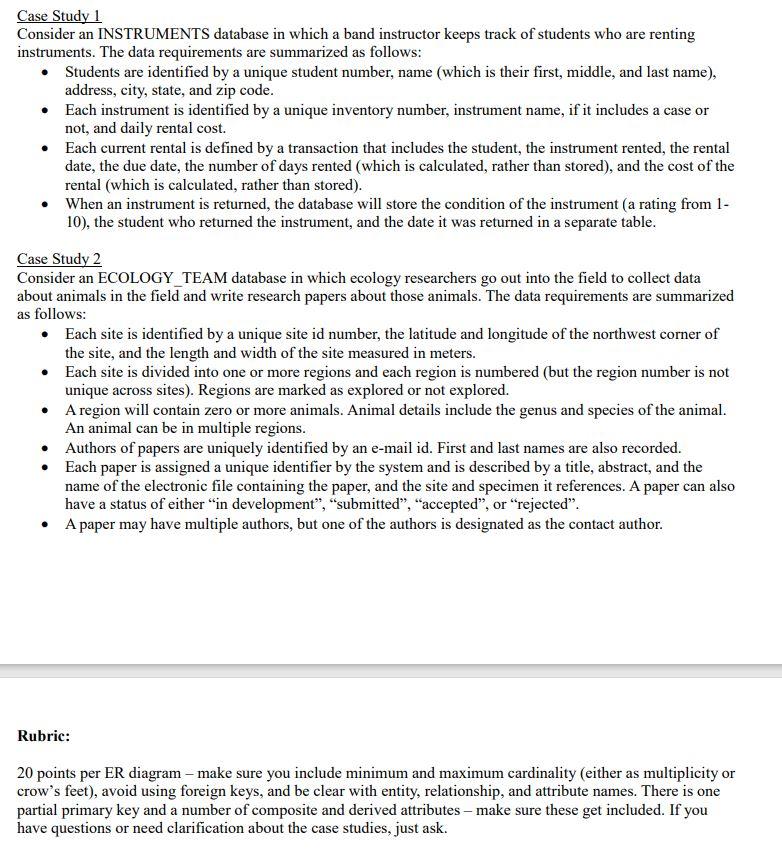Using LucidChart (or a modeling tool of your choice) create one UML ER diagram.
Could you please show me how to do Case Study 2.

Case Study 1 Consider an INSTRUMENTS database in which a band instructor keeps track of students who are renting instruments. The data requirements are summarized as follows: Students are identified by a unique student number, name (which is their first, middle, and last name), address, city, state, and zip code. Each instrument is identified by a unique inventory number, instrument name, if it includes a case or not, and daily rental cost. Each current rental is defined by a transaction that includes the student, the instrument rented, the rental date, the due date, the number of days rented (which is calculated, rather than stored), and the cost of the rental (which is calculated, rather than stored). When an instrument is returned, the database will store the condition of the instrument (a rating from 1- 10), the student who returned the instrument, and the date it was returned in a separate table. Case Study 2 Consider an ECOLOGY_TEAM database in which ecology researchers go out into the field to collect data about animals in the field and write research papers about those animals. The data requirements are summarized as follows: Each site is identified by a unique site id number, the latitude and longitude of the northwest corner of the site, and the length and width of the site measured in meters. Each site is divided into one or more regions and each region is numbered (but the region number is not unique across sites). Regions are marked as explored or not explored. A region will contain zero or more animals. Animal details include the genus and species of the animal. An animal can be in multiple regions. Authors of papers are uniquely identified by an e-mail id. First and last names are also recorded. Each paper is assigned a unique identifier by the system and is described by a title, abstract, and the name of the electronic file containing the paper, and the site and specimen it references. A paper can also have a status of either "in development", "submitted", "accepted", or "rejected". A paper may have multiple authors, but one of the authors is designated as the contact author. Rubric: 20 points per ER diagram - make sure you include minimum and maximum cardinality (either as multiplicity or crow's feet), avoid using foreign keys, and be clear with entity, relationship, and attribute names. There is one partial primary key and a number of composite and derived attributes - make sure these get included. If you have questions or need clarification about the case studies, just ask. Case Study 1 Consider an INSTRUMENTS database in which a band instructor keeps track of students who are renting instruments. The data requirements are summarized as follows: Students are identified by a unique student number, name (which is their first, middle, and last name), address, city, state, and zip code. Each instrument is identified by a unique inventory number, instrument name, if it includes a case or not, and daily rental cost. Each current rental is defined by a transaction that includes the student, the instrument rented, the rental date, the due date, the number of days rented (which is calculated, rather than stored), and the cost of the rental (which is calculated, rather than stored). When an instrument is returned, the database will store the condition of the instrument (a rating from 1- 10), the student who returned the instrument, and the date it was returned in a separate table. Case Study 2 Consider an ECOLOGY_TEAM database in which ecology researchers go out into the field to collect data about animals in the field and write research papers about those animals. The data requirements are summarized as follows: Each site is identified by a unique site id number, the latitude and longitude of the northwest corner of the site, and the length and width of the site measured in meters. Each site is divided into one or more regions and each region is numbered (but the region number is not unique across sites). Regions are marked as explored or not explored. A region will contain zero or more animals. Animal details include the genus and species of the animal. An animal can be in multiple regions. Authors of papers are uniquely identified by an e-mail id. First and last names are also recorded. Each paper is assigned a unique identifier by the system and is described by a title, abstract, and the name of the electronic file containing the paper, and the site and specimen it references. A paper can also have a status of either "in development", "submitted", "accepted", or "rejected". A paper may have multiple authors, but one of the authors is designated as the contact author. Rubric: 20 points per ER diagram - make sure you include minimum and maximum cardinality (either as multiplicity or crow's feet), avoid using foreign keys, and be clear with entity, relationship, and attribute names. There is one partial primary key and a number of composite and derived attributes - make sure these get included. If you have questions or need clarification about the case studies, just ask







